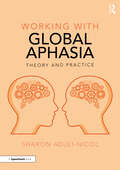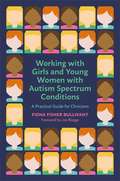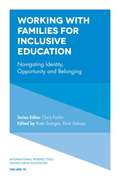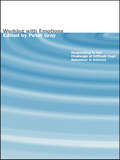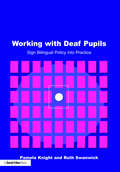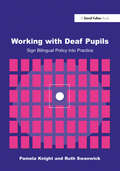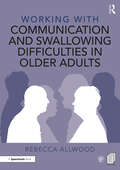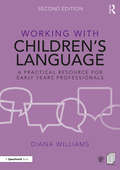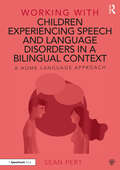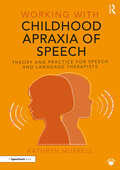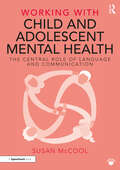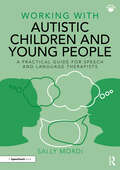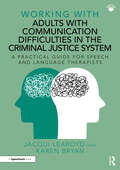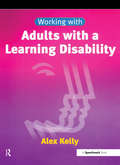- Table View
- List View
Working with Global Aphasia: Theory and Practice (Working With)
by Sharon Adjei-NicolGlobal aphasia is the most severe and disabling form of aphasia, yet it has had the least attention within aphasia research and rehabilitation. This practical book provides the reader with a comprehensive understanding of the topic based on both clinical observations and the literature to date. Uniquely, it covers not only the severe language impairments observed in global aphasia but also the co-occurring cognitive impairments that often present an additional challenge when working with this population. This book offers: • A comprehensive understanding of the clinical characteristics of global aphasia illustrated with real case examples • A theoretical overview of the domains of cognition and discussion of the role cognitive deficits play in the clinical presentation of people with global aphasia • Critical analysis of the research evidence on global aphasia • An exploration into the strengths and limitations of common methods used to assess language, cognition, and functional communication in global aphasia • New ways of approaching assessment and treatment which consider the impact of cognitive difficulties • Detailed suggestions of direct and indirect treatment tasks and approaches that can be used with this population, including novel cognitive tasks. This accessible text will provide both experienced speech and language therapists and students new to the subject with the knowledge, skills, and tools to work effectively with people with global aphasia in a range of clinical settings. It will also be an essential resource for anyone considering research with this challenging but highly rewarding population.
Working with Global Aphasia: Theory and Practice (Working With)
by Sharon Adjei-NicolGlobal aphasia is the most severe and disabling form of aphasia, yet it has had the least attention within aphasia research and rehabilitation. This practical book provides the reader with a comprehensive understanding of the topic based on both clinical observations and the literature to date. Uniquely, it covers not only the severe language impairments observed in global aphasia but also the co-occurring cognitive impairments that often present an additional challenge when working with this population. This book offers: • A comprehensive understanding of the clinical characteristics of global aphasia illustrated with real case examples • A theoretical overview of the domains of cognition and discussion of the role cognitive deficits play in the clinical presentation of people with global aphasia • Critical analysis of the research evidence on global aphasia • An exploration into the strengths and limitations of common methods used to assess language, cognition, and functional communication in global aphasia • New ways of approaching assessment and treatment which consider the impact of cognitive difficulties • Detailed suggestions of direct and indirect treatment tasks and approaches that can be used with this population, including novel cognitive tasks. This accessible text will provide both experienced speech and language therapists and students new to the subject with the knowledge, skills, and tools to work effectively with people with global aphasia in a range of clinical settings. It will also be an essential resource for anyone considering research with this challenging but highly rewarding population.
Working with Girls and Young Women with an Autism Spectrum Condition: A Practical Guide for Clinicians
by Fiona Fisher BullivantThis guide shows how clinicians can help girls and young women with ASC to reach their full potential, by adopting more relationship-based, individualised approaches. With contributions from young women about their experiences in clinical settings, the book reflects on what clinicians have done right and wrong to date, why girls and women with ASC are too often misunderstood, and how the culture of how clinicians work with them needs to change in order to achieve better results. In a concise and practical way, it covers how to better understand clients' needs and foster strong relationships through diagnosis, understanding comorbidities, sensory issues, self-harm, emotional regulation, assessments, interventions and strategies.
Working with Girls and Young Women with an Autism Spectrum Condition: A Practical Guide for Clinicians (PDF)
by Fiona Fisher BullivantThis guide shows how clinicians can help girls and young women with ASC to reach their full potential, by adopting more relationship-based, individualised approaches. With contributions from young women about their experiences in clinical settings, the book reflects on what clinicians have done right and wrong to date, why girls and women with ASC are too often misunderstood, and how the culture of how clinicians work with them needs to change in order to achieve better results. In a concise and practical way, it covers how to better understand clients' needs and foster strong relationships through diagnosis, understanding comorbidities, sensory issues, self-harm, emotional regulation, assessments, interventions and strategies.
Working with Families for Inclusive Education: Navigating Identity, Opportunity and Belonging (International Perspectives on Inclusive Education #10)
by Dick Sobsey Kate Scorgie Chris ForlinThis book explores personal, family and theoretical constructions of inclusion and offers evidence-based strategies and resources to foster parent-professional, home-school collaborative partnerships. It explores working with families to secure identity, opportunity and belonging within school settings and beyond. It does so by means of a rich international blend of scholarly articles and personal reflections. The first section examines personal, family, and theoretical perspectives on ways in which existing systems and structures define and influence inclusion of persons with disability and their families in school and workplace settings. It invites reflection on how we might come together to create more inclusive communities through mutual understanding and valuing. Section two presents a number of evidence-based practices, strategies, and resources that can serve to guide family members and professionals as they work together to build collaborative partnerships and inclusive school communities from preschool through transition to post-secondary and vocational settings. This book invites us to deeper understandings of collaboration, to engage reflection from diverse perspectives. It reminds us that at some level we are all navigating identity, opportunity and belonging; that each of us needs those who challenge us to see beyond our assumptions, whose ideas shape and sharpen our own.
Working with Families for Inclusive Education: Navigating Identity, Opportunity and Belonging (International Perspectives on Inclusive Education #10)
by Dick Sobsey Kate Scorgie Chris ForlinThis book explores personal, family and theoretical constructions of inclusion and offers evidence-based strategies and resources to foster parent-professional, home-school collaborative partnerships. It explores working with families to secure identity, opportunity and belonging within school settings and beyond. It does so by means of a rich international blend of scholarly articles and personal reflections. The first section examines personal, family, and theoretical perspectives on ways in which existing systems and structures define and influence inclusion of persons with disability and their families in school and workplace settings. It invites reflection on how we might come together to create more inclusive communities through mutual understanding and valuing. Section two presents a number of evidence-based practices, strategies, and resources that can serve to guide family members and professionals as they work together to build collaborative partnerships and inclusive school communities from preschool through transition to post-secondary and vocational settings. This book invites us to deeper understandings of collaboration, to engage reflection from diverse perspectives. It reminds us that at some level we are all navigating identity, opportunity and belonging; that each of us needs those who challenge us to see beyond our assumptions, whose ideas shape and sharpen our own.
Working with Emotions: Responding to the Challenge of Difficult Pupil Behaviour in Schools
by Peter GrayDifficult pupil behaviour presents a number of issues for teachers, parents, other pupils as well as for children themselves. Inevitably it raises a number of emotions and challenges people's sense of their own personal effectiveness.This edited collection of short, concise chapters provides advice and guidance to professionals on how to respond to the emotions experienced and generated by pupils with behavioural difficulties in schools. Many chapters are written by such professionals themselves and address common problems in a practical and accessible way. Working with Emotions is an essential text for all schools, support services, LEAs, SENCOs and voluntary agencies and includes discussions on the government's current Social Inclusion initiative.
Working with Emotions: Responding to the Challenge of Difficult Pupil Behaviour in Schools
by Peter GrayDifficult pupil behaviour presents a number of issues for teachers, parents, other pupils as well as for children themselves. Inevitably it raises a number of emotions and challenges people's sense of their own personal effectiveness.This edited collection of short, concise chapters provides advice and guidance to professionals on how to respond to the emotions experienced and generated by pupils with behavioural difficulties in schools. Many chapters are written by such professionals themselves and address common problems in a practical and accessible way. Working with Emotions is an essential text for all schools, support services, LEAs, SENCOs and voluntary agencies and includes discussions on the government's current Social Inclusion initiative.
Working with Deaf Children: Sign Bilingual Policy into Practice
by Pamela Knight Ruth SwanwickThis book is essential and accessible reading for all teachers and professionals who are working with sign bilingual deaf children. It considers the background and theory underpinning current developments in sign bilingual education and the implications for policy and developing classroom practice. Practical teaching strategies are suggested and evaluated. The authors draw on their own experience of working in sign bilingual settings as well as current good practice and relevant research. This book is the first UK book that describes sign bilingual education (beyond policy). It is also the first book to support sign bilingual practice dealing with current educational issues. The authors draw together relevant research and practice in sign bilingual education and present practical strategies for teachers.
Working with Deaf Children: Sign Bilingual Policy into Practice
by Pamela Knight Ruth SwanwickThis book is essential and accessible reading for all teachers and professionals who are working with sign bilingual deaf children. It considers the background and theory underpinning current developments in sign bilingual education and the implications for policy and developing classroom practice. Practical teaching strategies are suggested and evaluated. The authors draw on their own experience of working in sign bilingual settings as well as current good practice and relevant research. This book is the first UK book that describes sign bilingual education (beyond policy). It is also the first book to support sign bilingual practice dealing with current educational issues. The authors draw together relevant research and practice in sign bilingual education and present practical strategies for teachers.
Working with Communication and Swallowing Difficulties in Older Adults (Working With)
by Rebecca AllwoodThis accessible resource offers valuable guidance for all student and practising speech and language therapists (SLTs)who are working with older people with communication and swallowing difficulties. Chapters provide up-to-date theory on age-related changes alongside practical strategies for clinicians to use in their daily work, from help with mental capacity decisions to supporting older people with good palliative care. Promoting a holistic approach for ageing well, this resource dispels myths that surround the ageing process while detailing the normal physiological and psychological effects of ageing on communication and swallowing, as well as diseases and conditions associated with older age, such as frailty. Illustrated throughout with clinical case studies and helpful photocopiable resources to use in practice, this book is a key part of the tool kit for any speech and language therapist working with older adults.
Working with Communication and Swallowing Difficulties in Older Adults (Working With)
by Rebecca AllwoodThis accessible resource offers valuable guidance for all student and practising speech and language therapists (SLTs)who are working with older people with communication and swallowing difficulties. Chapters provide up-to-date theory on age-related changes alongside practical strategies for clinicians to use in their daily work, from help with mental capacity decisions to supporting older people with good palliative care. Promoting a holistic approach for ageing well, this resource dispels myths that surround the ageing process while detailing the normal physiological and psychological effects of ageing on communication and swallowing, as well as diseases and conditions associated with older age, such as frailty. Illustrated throughout with clinical case studies and helpful photocopiable resources to use in practice, this book is a key part of the tool kit for any speech and language therapist working with older adults.
Working with Children’s Language: A Practical Resource for Early Years Professionals (Working With)
by Diana WilliamsThis revised and updated second edition of Working with Children’s Language has been created to support practitioners who work with young children with delayed language acquisition. Rooted in a developmental theory of language learning, it covers topics such as attention control and listening, the role of play, verbal comprehension and the acquisition of spoken expressive language. Each chapter offers a straightforward overview of current research relating to the specific language skill before introducing a wealth of targeted games and activities that can help support the development of those skills. Key features include: • A structured approach to language learning that can be followed as a programme or adapted for informal use by individual practitioners. • Accessible activities, games and ideas suitable for small group or individual intervention, linked to specific aims based on developmental norms. • Photocopiable and downloadable resources, including a record sheet to track progress in each skill against aims and outcomes for individual children. Clearly linking theory and practice in an engaging and easy-to-follow format, this is an invaluable resource to support children in early years settings and Key Stage 1 whose language is delayed, but who are otherwise developing normally. It is a must-have book for early years practitioners, teachers, SEND professionals and speech and language therapists with varying levels of experience.
Working with Children’s Language: A Practical Resource for Early Years Professionals (Working With)
by Diana WilliamsThis revised and updated second edition of Working with Children’s Language has been created to support practitioners who work with young children with delayed language acquisition. Rooted in a developmental theory of language learning, it covers topics such as attention control and listening, the role of play, verbal comprehension and the acquisition of spoken expressive language. Each chapter offers a straightforward overview of current research relating to the specific language skill before introducing a wealth of targeted games and activities that can help support the development of those skills. Key features include: • A structured approach to language learning that can be followed as a programme or adapted for informal use by individual practitioners. • Accessible activities, games and ideas suitable for small group or individual intervention, linked to specific aims based on developmental norms. • Photocopiable and downloadable resources, including a record sheet to track progress in each skill against aims and outcomes for individual children. Clearly linking theory and practice in an engaging and easy-to-follow format, this is an invaluable resource to support children in early years settings and Key Stage 1 whose language is delayed, but who are otherwise developing normally. It is a must-have book for early years practitioners, teachers, SEND professionals and speech and language therapists with varying levels of experience.
Working with Children Experiencing Speech and Language Disorders in a Bilingual Context: A Home Language Approach (Working With)
by Sean PertThe complexity of speech and language disorders can be daunting in a monolingual context. When working with a bilingual child assessment and intervention may appear to be even more complicated. In this book Sean Pert provides the reader with the tools needed to overcome this perception and develop skills in working in a language that they don’t share with the client. By adopting a home language first approach the book discusses how to: identify diversity from disorder introduce effective approaches in line with the best clinical practice work successfully alongside interpreters make assessments and plan interventions set goals for therapy. At the heart of the text is the therapist creating essential partnerships with parents and truly valuing the bilingualism, culture and identity of the child. This leads to better outcomes, not only in speech, language and communication, but also in self-esteem, mental health, social participation and educational and employment success. The book concludes with a handy toolkit of resources including quizzes, case studies and printable extras making it the perfect resource for both experienced and newly qualified practitioners with bilingual and multilingual children in their care.
Working with Children Experiencing Speech and Language Disorders in a Bilingual Context: A Home Language Approach (Working With)
by Sean PertThe complexity of speech and language disorders can be daunting in a monolingual context. When working with a bilingual child assessment and intervention may appear to be even more complicated. In this book Sean Pert provides the reader with the tools needed to overcome this perception and develop skills in working in a language that they don’t share with the client. By adopting a home language first approach the book discusses how to: identify diversity from disorder introduce effective approaches in line with the best clinical practice work successfully alongside interpreters make assessments and plan interventions set goals for therapy. At the heart of the text is the therapist creating essential partnerships with parents and truly valuing the bilingualism, culture and identity of the child. This leads to better outcomes, not only in speech, language and communication, but also in self-esteem, mental health, social participation and educational and employment success. The book concludes with a handy toolkit of resources including quizzes, case studies and printable extras making it the perfect resource for both experienced and newly qualified practitioners with bilingual and multilingual children in their care.
Working with Childhood Apraxia of Speech: Theory and Practice for Speech and Language Therapists (Working With)
by Kathryn MurrellThis resource will lead the reader through the practicalities of assessment, diagnosis, and therapeutic intervention for children of all ages with features of childhood apraxia of speech. It provides the theory and underlying principles upon which to work with children who have this fascinating but challenging disorder in collaboration with families and schools.Chapters are clearly laid out, with hands on activities for intervention and helpful summaries. There is a focus on alternative and augmentative means of communication and multidisciplinary working, as well as a wealth of case studies and teaching notes for training other professionals. Fresh ways of working are addressed, such as the use of teletherapy and other techniques such as group therapy and the consultative approach are discussed.Key features include: A theoretical overview of current thinking about childhood apraxia of speech A structured assessment format with a chapter specifically focused on how to take a detailed speech sample Clear guidance on how to make a differential diagnosis How to spot early indicators of childhood apraxia of speech Advice sheets for parents and schools Downloadable record forms for case history taking and assessment. This book can be read cover to cover or dipped into for quick and easy therapy ideas and is presented in an easy-to-read format, with chapters broken down into bite-sized chunks. It is an essential handbook for all speech and language therapists and students, whatever their level of experience.
Working with Childhood Apraxia of Speech: Theory and Practice for Speech and Language Therapists (Working With)
by Kathryn MurrellThis resource will lead the reader through the practicalities of assessment, diagnosis, and therapeutic intervention for children of all ages with features of childhood apraxia of speech. It provides the theory and underlying principles upon which to work with children who have this fascinating but challenging disorder in collaboration with families and schools.Chapters are clearly laid out, with hands on activities for intervention and helpful summaries. There is a focus on alternative and augmentative means of communication and multidisciplinary working, as well as a wealth of case studies and teaching notes for training other professionals. Fresh ways of working are addressed, such as the use of teletherapy and other techniques such as group therapy and the consultative approach are discussed.Key features include: A theoretical overview of current thinking about childhood apraxia of speech A structured assessment format with a chapter specifically focused on how to take a detailed speech sample Clear guidance on how to make a differential diagnosis How to spot early indicators of childhood apraxia of speech Advice sheets for parents and schools Downloadable record forms for case history taking and assessment. This book can be read cover to cover or dipped into for quick and easy therapy ideas and is presented in an easy-to-read format, with chapters broken down into bite-sized chunks. It is an essential handbook for all speech and language therapists and students, whatever their level of experience.
Working with Child and Adolescent Mental Health: The Central Role of Language and Communication (Working With)
by Susan McCoolIn children, mental health challenges and communication differences typically combine in complex and inter-related ways. Remarkably, this crucial point is all too often forgotten, and communication is overlooked. Services are frequently fragmented, leading professionals to look at children through distinct lenses of either mental health or communication, meaning insights can be incomplete and important perspectives unshared. Working with Child and Adolescent Mental Health makes the compelling case that communication is central and should be a primary consideration whenever we think about children’s mental health. With a practical focus, and an easy- to-read format, it suggests how this can be achieved by identifying how practitioners and services can work more cohesively to understand and optimise children’s communication capacities. This book includes: Practical advice, grounded in current research, and presented in an easy-to-read, digestible style Guidance to help practitioners competently and compassionately identify and respond to the needs of children and young people with complex combined communication and mental health needs Real-life case studies from a wide range of settings, unpicked to clearly illustrate topics discussed in the book and offer encouragement and inspiration to practitioners Checklists and questionnaires to help practitioners in daily practice Recommendations for, and links to, useful additional resources Tools to support reflection and enhancement for individual practitioners and services Essential reading for speech and language therapists, psychologists, mental health practitioners, educators, social workers, and anyone else concerned with children’s wellbeing and resilience, this book highlights the transformational impact of placing communication at the heart of all efforts to support children and young people’s mental health.
Working with Child and Adolescent Mental Health: The Central Role of Language and Communication (Working With)
by Susan McCoolIn children, mental health challenges and communication differences typically combine in complex and inter-related ways. Remarkably, this crucial point is all too often forgotten, and communication is overlooked. Services are frequently fragmented, leading professionals to look at children through distinct lenses of either mental health or communication, meaning insights can be incomplete and important perspectives unshared. Working with Child and Adolescent Mental Health makes the compelling case that communication is central and should be a primary consideration whenever we think about children’s mental health. With a practical focus, and an easy- to-read format, it suggests how this can be achieved by identifying how practitioners and services can work more cohesively to understand and optimise children’s communication capacities. This book includes: Practical advice, grounded in current research, and presented in an easy-to-read, digestible style Guidance to help practitioners competently and compassionately identify and respond to the needs of children and young people with complex combined communication and mental health needs Real-life case studies from a wide range of settings, unpicked to clearly illustrate topics discussed in the book and offer encouragement and inspiration to practitioners Checklists and questionnaires to help practitioners in daily practice Recommendations for, and links to, useful additional resources Tools to support reflection and enhancement for individual practitioners and services Essential reading for speech and language therapists, psychologists, mental health practitioners, educators, social workers, and anyone else concerned with children’s wellbeing and resilience, this book highlights the transformational impact of placing communication at the heart of all efforts to support children and young people’s mental health.
Working with Autistic Children and Young People: A Practical Guide for Speech and Language Therapists (Working With)
by Sally MordiThis book focuses on appreciating the different language and communication style of autistic youngsters and discusses how therapists can respond to and support this to get the best out of their practice. Each chapter begins with a summary of key points and areas to focus on, includes ‘what to do’ ideas and mini case-studies to illustrate points, as well as signposting further reading. The book draws on relevant theory and offers practical insights to allow the therapist to develop confidence, knowledge and skills. Topics covered include: identifying effective support, emotional regulation, working with technology, specific groups such as girls with autism. Linking theory and practice in an engaging and easy-to-follow format, The book provides practical ideas that are immediately helpful for busy professionals to guide clinical decision making and intervention. It is an invaluable addition to the tool kit of any speech and language therapist, as well as other professionals wanting an overview of how to work with autistic children and young people in our neurodiverse society.
Working with Autistic Children and Young People: A Practical Guide for Speech and Language Therapists (Working With)
by Sally MordiThis book focuses on appreciating the different language and communication style of autistic youngsters and discusses how therapists can respond to and support this to get the best out of their practice. Each chapter begins with a summary of key points and areas to focus on, includes ‘what to do’ ideas and mini case-studies to illustrate points, as well as signposting further reading. The book draws on relevant theory and offers practical insights to allow the therapist to develop confidence, knowledge and skills. Topics covered include: identifying effective support, emotional regulation, working with technology, specific groups such as girls with autism. Linking theory and practice in an engaging and easy-to-follow format, The book provides practical ideas that are immediately helpful for busy professionals to guide clinical decision making and intervention. It is an invaluable addition to the tool kit of any speech and language therapist, as well as other professionals wanting an overview of how to work with autistic children and young people in our neurodiverse society.
Working With Adults with Communication Difficulties in the Criminal Justice System: A Practical Guide for Speech and Language Therapists (Working With)
by Jacqui Learoyd Karen BryanThis book offers guidance for speech and language therapists and other professionals who are working in a criminal justice setting or who are interested to know more about this dynamic and rewarding client group. The criminal justice system (CJS) includes police custody, community services, secure hospitals and prisons. Although each setting has its differences, there are overarching areas associated with speech, language and communication needs (SLCN) within the population who find themselves coming into contact with the CJS. These needs are many and varied: from social deprivation and developmental language disorder, to head injury, substance misuse and ADHD. The variety is both stimulating and challenging, and this book provides the reader with a range of resources to use with such a complex client base. Key features include: ● academic evidence about SLCN in the CJS ● accessible visuals explaining the systems pathways ● resources to support assessment and intervention ● information to support individuals with a range of overlapping needs. Aimed primarily at speech and language therapists, the book also includes useful content for students, academics and professionals who wish to know more about SLCN within the CJS. As well as being full of useful infographics, this book includes a vast appendix of online material that can be downloaded and printed for use in practice.
Working With Adults with Communication Difficulties in the Criminal Justice System: A Practical Guide for Speech and Language Therapists (Working With)
by Jacqui Learoyd Karen BryanThis book offers guidance for speech and language therapists and other professionals who are working in a criminal justice setting or who are interested to know more about this dynamic and rewarding client group. The criminal justice system (CJS) includes police custody, community services, secure hospitals and prisons. Although each setting has its differences, there are overarching areas associated with speech, language and communication needs (SLCN) within the population who find themselves coming into contact with the CJS. These needs are many and varied: from social deprivation and developmental language disorder, to head injury, substance misuse and ADHD. The variety is both stimulating and challenging, and this book provides the reader with a range of resources to use with such a complex client base. Key features include: ● academic evidence about SLCN in the CJS ● accessible visuals explaining the systems pathways ● resources to support assessment and intervention ● information to support individuals with a range of overlapping needs. Aimed primarily at speech and language therapists, the book also includes useful content for students, academics and professionals who wish to know more about SLCN within the CJS. As well as being full of useful infographics, this book includes a vast appendix of online material that can be downloaded and printed for use in practice.
Working with Adults with a Learning Disability (Working With Series)
by Alex KellyA comprehensive and practical resource for all speech and language therapists and students, this book covers all aspects of working with this client group. Written by the author of the hugely successful "Talkabout", each section gives the reader a theoretical background of the subject under discussion, practical suggestions and formats for assessment, a guide to intervention as well as a clear and worked-out example. In addition, the author addresses staff training, group therapy, accessing the criminal justice system and working with a multi-disciplinary team.
